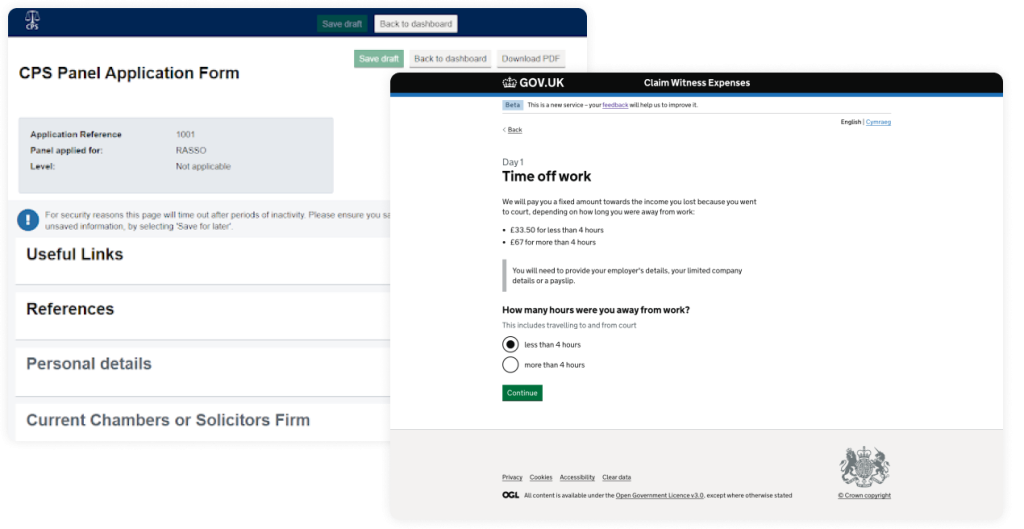ARTICLE AD BOX
 The CPS embraced low code applications to tranform its online applications. (Image: Shutterstock)
The CPS embraced low code applications to tranform its online applications. (Image: Shutterstock)
It’s been over a decade since the UK public sector embraced a ‘Cloud First’ approach to digital services. As a result, the government has largely achieved its initial goal of increasing the efficiency and affordability of its IT systems across multiple departments – not least in the Crown Prosecution Service (CPS), where the adoption of a ‘services, not servers’ approach to doing business online sparked a long and fruitful journey with low code, one that, 38 apps later, has proven transformative.
Like many public bodies, the CPS was steeped in Excel spreadsheets, restricted by tight budgets and had limited access to IT talent. The organisation was run largely on paper-based processes and many of its digital tools had performance issues and lacked functionality.
As part of its transition to the cloud, the CPS decided to reevaluate many of these tools. It had more than 50 local applications that were built using a ‘no-code’ approach, many of which had performance issues and left users wanting when it came to functionality. It was decided now was an opportune moment to upgrade these applications and host them in the cloud. But having previously outsourced such development, in-house experience at the CPS in this area was, at best, callow. As such, says the organisation’s head of software engineering Liz Thomason, “we didn’t have the right tools, skills or processes to support traditional development.”
Leveraging low code
Scalability was also an issue. The CPS employs around 7,000 people, almost all of whom are engaged in the pursuit of justice for countless victims of crime – a high-stakes business at the best of times and one that, in an ideal world, could rely on the expertise of hundreds of IT staff. Thomason did not have that. What she did have was a duo of skilled developers, that eventually flourished to nine, specialists she knew were best tasked with creating lasting solutions that could evolve alongside the CPS’s ever-changing mission.
Thomason, who at the time only had some basic front-end coding experience, decided to start slowly. She made it her business to find the right tools that could show value early on while building the skills of her team rapidly and “ensuring any new applications were built in a secure, efficient and cost-effective manner.”
It was this process that led Thomason and her team to discover a low-code platform called OutSystems. Backed by what she describes as a “package of customer success services” for advice and upskilling, after six months, Thomason delivered her first application: an app to gather data for standard operating procedures. This, she says, provided “immediate value” and has, to date, processed over a million records. Thomason’s team also built and released reusable common features including integrations and authentication mechanisms, replaced legacy applications and delivered smaller apps designed to improve internal processes.
These rendered functionality improvements including more intuitive interfaces, simpler and faster data entry, and built-in reporting that gave managers 24/7 real-time information which started benefiting day-to-day operations.
“Quite rapidly we found that people were submitting requests where they outlined a business problem and pointed to one of our apps and said they wanted a solution ‘like that,’” recalls Thomason. “And instead of outsourcing, which can come at a premium, we now have the means to handle those requests ourselves.”
As the team’s confidence grew, they better translated user needs into solutions and the scope and scale of the apps they delivered grew. Applications derived from this low code approach included an Advocate Panel app for private sector barristers and solicitors to apply to CPS advocate panels. That platform, says Thomason, replaced a “very laborious, manual, and at times, confusing process” that required filling out multiple forms and the circulation of significant volumes of material by email between multiple stakeholders.
More recently, low code was used to develop an application for witnesses to submit expense claims, digitising from end-to-end a process that was previously paper-based. A recent user survey found that 89% of respondents found it ‘easy’ or ‘very easy’ to use. 64% of those polled, meanwhile, said that the time it took to get repaid was reduced from a period of several weeks to about a day.
All of these applications, says Thomason, have taken an average of just four months to build. “Another benefit has been the ability to focus on development skills, while the overhead platform is managed by the supplier,” she adds, “which has reduced maintenance costs compared to traditional development methods.”
But from the outset, argues Thomason, having a strong focus on reusable shared components to maximise the value of built applications and an ‘agile mindset’ have been crucial to the CPS’s success. “Having a visual development environment allows us to rapidly prototype, develop and release early versions of solutions then further iterate at pace,” she explains. “This means we can respond to the changing needs of our users with greater efficiency.”
The team is now looking to build core strategic systems within the CPS rather than just around the edges. This includes the Future Casework Tools portfolio, which encompasses the Case Management System, witness and management information systems, as well as various interfaced and standalone applications. “We are adopting a user-centric approach to developing these tools,” says Thomason, “seamlessly blending low code front-end and logic and integrating with data elsewhere in many of these solutions.”
 Some of the low code applications created by the CPS. (Image: Crown Prosecution Service)
Some of the low code applications created by the CPS. (Image: Crown Prosecution Service)Future of low code
Recent years have seen a massive expansion of low-code tools, with the market for such platforms projected to reach $36.43 billion by 2027. Bradley Shimmin, chief analyst for AI platforms, analytics, and data management at Omdia Applied Intelligence, says that low code is just the latest way coding has been abstracted for ever-wider use – a journey the medium has been on for several decades now. “Using these tools, companies can do more and build more software, while making their businesses more optimized and more able to tackle new opportunities,” says Shimmin.
The next evolution of this is generative AI which is cognizant of, and thus opens up, many other programming languages for businesses to access, such as Java, C, TypeScript or even Rust. In theory, companies could harness generative AI-powered agentic workflows to help build Rust-based apps, argues Shimmins – though, he adds, current technology isn’t quite capable of this just yet. “Neither the supporting tools nor the GenAI models themselves are mature enough to take humans out of the loop,” he says.
Shimmins also warns that, whether writing code by hand, using low code, or no code or emerging GenAI, companies cannot outrun broader IT issues like technical debit – which is where the more capable the software becomes, the more code there is to maintain.
As a coding novice, when starting out, what are Thomason’s takeaways to others considering embarking on a similar journey? “My advice would be to know your requirements and look to find a low code solution that addresses it,” she tells Tech Monitor. “Not having a low code solution in your toolset immediately disadvantages your efficiency.”

 8 months ago
16
8 months ago
16


